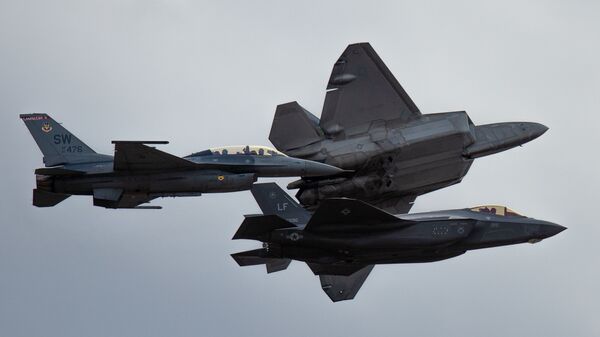A F-16C Viper belonging to the 49th Air Wing crashed while landing at Holloman AFB at about 6 pm local time Monday. The pilot managed to eject successfully and is being treated for minor injuries.
Details have yet to emerge regarding the cause of the crash, but it does add to the troubling trend of incidents involving US Air Force and Navy aircraft. Seven warplanes have reportedly crashed in the past two months alone, including F-15s and F/A-18Fs, as well as the cutting-edge F-35.
- On June 30, an F-16CM from the 20th Fighter Wing at Shaw Air Force Base in South Carolina crashed during a routine training flight, killing its pilot. The incident caused a major blaze on base. The deceased pilot, Lt. David Schmitz, was preparing to deploy overseas for combat operations, according to the military.
USAF’s F-16 assigned to 20 Fighter Wing Crashes at Shaw AFB
— Pakistan Strategic Forum (@ForumStrategic) July 1, 2020
2020 is proving to be worst for Aviation Industry. pic.twitter.com/99fR8QyGEd
- On June 18, two Navy pilots ejected from their Boeing F/A-18F Super Hornet fighter jet just before it crashed into the Philippine Sea, also during a training mission, and were rescued by a helicopter aboard the USS Theodore Roosevelt. No cause for the crash was given, with the military indicating only that an investigation was underway. The plane is thought to have belonged to the ‘Black Knights’ squadron, stationed aboard the Roosevelt. The incident took place not long after the Roosevelt resumed its operations in the Western Pacific after spending months in port after hundreds of crew members came down with coronavirus.
- Three days earlier, on June 15, the British Coast Guard discovered the wreckage of a US Air Force McDonnell Douglas F-15C Eagle after it crashed in the North Sea off the coast of Yorkshire that morning. The pilot, Lt. Kenneth Allen, was killed in the incident, which again took place during a routine training flight. The fighter was based at the 48th Fighter Wing at RAF Lakenheath, where the US Air Force has maintained operations since shortly after World War 2.

- On June 9, the 388th Fighter Wing at Utah’s Hill Air Force Base reported that an Air Force pilot received need for a medical evaluation after a landing mishap which saw his Lockheed Martin F-35 Lightning II fighter jet’s landing gear collapse after a routine flight. The incident was apparently significant enough to close the base’s airstrip, forcing other aircraft in the area to divert to nearby airfields.
- That incident came several weeks after another F-35, this one from Eglin Air Force Base in western Florida, was lost during a routine night training sortie on the night of May 19. Fortunately, the pilot managed to eject in time. No other casualties or damage (apart from the $80 million plane itself) were reported.
- Several days earlier, an Air Force Lockheed Martin F-22 Raptor stealth fighter from the 43rd Fighter Squadron was lost about 20 km northeast of Eglin after crashing on the morning of May 15. Its pilot also managed to eject in time. According to reports, the fighter was involved in the “America Strong” flyover tour dedicated to thanking health care workers, first responders, the military and others fighting the COVID-19 pandemic.

Given the range of aircraft involved, from Cold War-era F-15s and F-16s to the much newer F-22s and F-35s, it does not appear that ageing equipment is a pattern for the recent string of incidents. Inadequate pilot training, hardware malfunctions, software glitches, or other problems may be more likely, although the military has so far kept tight-lipped about the causes of each of these crashes. So far, the only known factor linking all but one of these incidents is that they were said to have taken place during ‘routine training’ over friendly (US or NATO) airspace.
In any event, the losses are significant, particularly given that the last time a US fighter jet was actually destroyed by enemy combatants was in April 2003, when an F-15E was shot down over Tikrit, Iraq during the US invasion. Before that, the US lost two planes – a stealthy F-117 Nighthawk bomber and an F-16C, during the NATO bombing of Yugoslavia in 1999.



